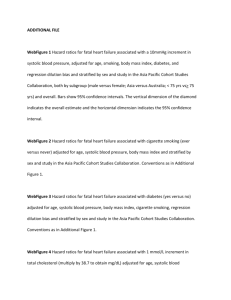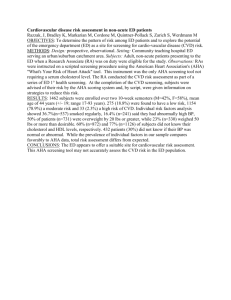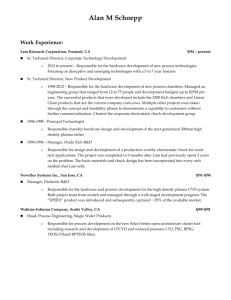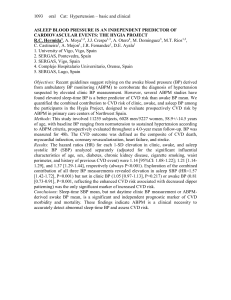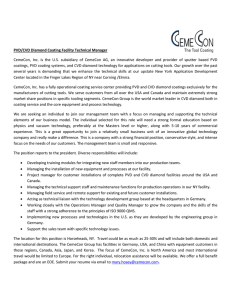Trade Remedies in Renewable Energy: A Global Survey Takeaways from the literature 03.04.2014
advertisement
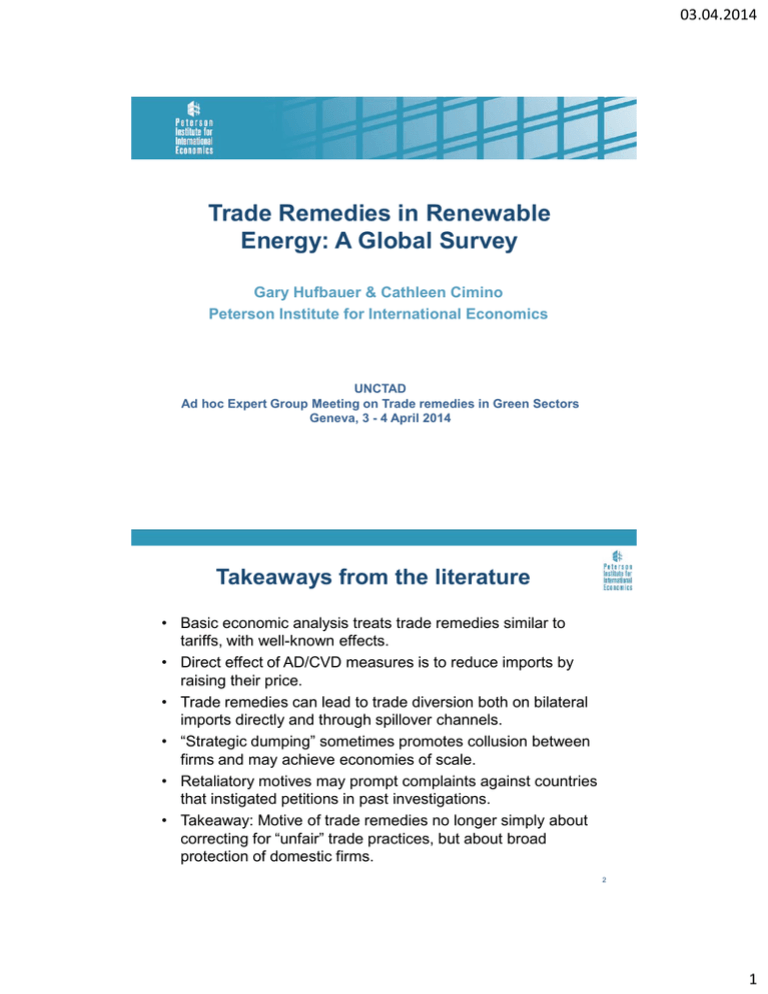
03.04.2014 Trade Remedies in Renewable Energy: A Global Survey Gary Hufbauer & Cathleen Cimino Peterson Institute for International Economics UNCTAD Ad hoc Expert Group Meeting on Trade remedies in Green Sectors Geneva, 3 - 4 April 2014 Takeaways from the literature • Basic economic analysis treats trade remedies similar to tariffs, with well-known effects. • Direct effect of AD/CVD measures is to reduce imports by raising their price. • Trade remedies can lead to trade diversion both on bilateral imports directly and through spillover channels. • “Strategic dumping” sometimes promotes collusion between firms and may achieve economies of scale. • Retaliatory motives may prompt complaints against countries that instigated petitions in past investigations. • Takeaway: Motive of trade remedies no longer simply about correcting for “unfair” trade practices, but about broad protection of domestic firms. 2 1 03.04.2014 Concerns regarding trade remedies targeting renewable energy (RE) 1. Higher prices for green products will lead to less accessibility for user industries and consumers; 2. Higher price of renewable electricity could erode competitiveness with fossil fuels to the detriment of the environment; 3. Raised costs of intermediate inputs will affect downstream firms in the supply chain, thereby undermining “supply chain optimization”; 4. Retaliatory behavior will increase among targeted countries. 3 Survey of trade remedies in RE sector • • • • Global survey: identified AD and CVD cases in the RE sector from 2008 through early 2014, based on data from (1) Temporary Trade Barriers database created by Chad Bown at the World Bank and (2) official government sources. Identification: AD/CVD cases specify disaggregated codes at the 8- or 10digit HTS product level, which as a rule can be readily identified as RE products. WTO and APEC lists of EGs guided product identification. Recorded 41 cases: 26 anti-dumping cases and 15 parallel subsidy investigations. Cases targeting multiple countries but the same products are counted separately. Six countries pursued renewable investigations: Australia, China, the European Union, India, Peru, and the United States. • • • EU initiated the greatest number of AD/CVD cases, namely 18 cases, or two-fifths of the renewable cases identified. US and China accounted for 8 and 5 of the cases initiated, respectively. Products targeted: 16 cases involved biofuels; 18 cases involved solar energy products; and 7 cases involved wind energy products. 4 2 03.04.2014 Countries that impose trade remedies targeting renewable energy products AD cases CVD cases Renewable GDP, electricity net Cases Cases 2012 generation, targeting Total targeting Total (US$ 2012 RE since cases RE since cases Country billions) (TWh)a 2008 (2008-12)b 2008 (2008-12)b Total imports affected for 41 cases in renewables (US$ millions)c Australia 1,532 29 3 49 1 7 456 China 8,227 797 3 53 2 6 2,144 EU 16,687 684 10 75 8 21 24,408 India 1,842 162 4 167 0 0 502 Peru 204 22 1 10 1 7 40 16,245 508 5 68 3 44 4,414 n.a. n.a. 26 422 15 85 31,965 US Total n.a. = not applicable; TWh = terawatt hours; RE = renewable energy a Data for China and India from 2011; EU data from 2010; all other data from 2012. b The total number of AD and CVD cases is through year-end 2012. c Calculated as average imports from 2009 through year measure imposed; trade based on HTS codes identified in AD/CVD case. Sources: World Bank, WDI Database; US Energy Information Administration; AD/CVD cases from Bown (2012a) and (2012b); total 5 imports affected from authors' calculations. Estimated trade reduced from AD/CVD cases • • • • • • The simple average of dumping and subsidy ad valorem duties is 27% and 26%, respectively. For cases with parallel AD/CVD investigations, the total combined penalties averaged 59%. For cases with specific duties (e.g., based on weight or volume) we use the calculated dumping/subsidy margins or estimate AV equivalents. Importantly, AD/CVD duties are levied on top of existing duties; this is important for biofuels, but less for solar and wind, which generally have low applied tariffs. To estimate the reduction of trade in RE products, we assume an elasticity of import demand of -1.0 (i.e., a 1% increase in price of the good results in a 1% decrease in the quantity imported). Based on this assumption, we broadly estimate the total reduction of trade to be about $14 billion annually. As AD and CVD penalties are effective for 5 years (pending sunset review), this translates to global trade loss of $68 billion over 5 years. 6 3 03.04.2014 Estimated RE trade reduced by country Value of imports from respondent country (US$ millions) Complainant country SGP TWN US VTN Total trade 0 0 0 9 0 80 83 0 0 0 464 0 953 164 0 0 0 0 2,626 0 8,004 ARG CAN CHN EU INDO Australia 0 0 70 0 0 2 China 0 0 0 406 0 441 4,427 0 European Union 347 KOR MYS India 0 0 66 0 0 0 19 0 25 21 0 132 Peru 0 0 0 0 0 0 0 0 0 19 0 19 United States 0 0 4,128 0 0 0 0 0 222 0 46 4,396 347 441 164 85 19 0 246 3,138 46 13,584 Total trade 8,692 406 Note: All initiated AD/CVD cases are included regardless of the outcome, i.e., whether ruled affirmative, negative, or withdrawn. Source: Authors' calculations. 7 Products targeted in AD/CVD investigations Total trade affected Renewable energy product Biofuels Solar energy cSi PV cells & modules Solar grade polysilicon Solar glass Wind energy Glass fiber products Wind turbines Total Number of Value % of AD/CVD (US$ total global cases millions) trade 16 9,404 3.6 Value (US$ millions) 3,605 % of total global trade 1.4 Global trade in targeted renewable energy products (US$ billions)a 259 Estimated trade reduced 11 5 2 19,230 2,144 146 21.7 29.5 6.8 8,549 953 61 9.6 12.0 2.8 89 7 2 2 5 41 238 3.2 8.3 8.5 24 393 13,584 0.3 4.1 3.6 7 10 374 804 31,965 a Total global trade estimated based on the 6-digit HS codes that correspond to the HTS codes specified in each AD/CVD case. Global trade is calculated as the average imports of specified products in recent years, 2009 to 2012. Because 6-digit HS codes include some unrelated products this is an imprecise overestimate of actual global trade in the specified renewable energy products. For some cases, identification of which 6-digit HS codes to draw on from the AD/CVD cases relied on authors' judgment. Sources: Trade affected and trade reduced authors' calculations; global trade from World Bank WITS database and authors' calculations. 8 4 03.04.2014 WTO cases targeting RE • The number of AD/CVD cases far outnumbers the handful of disputes that have arrived at the WTO. • Trade remedies “offer a much faster, direct, and politically popular means of response to unfair industrial policies compared to WTO disputes” (Wu and Salzman 2013). • But nearly a dozen WTO dispute cases have been pursued since 2010; concentrated in countries at the helm of AD/CVD cases, including Argentina, China, EU, India, and the US. • Two disputes directly relate to the proceedings of trade remedy cases (Argentina vs. EU and China vs. US) • Many cases have not proceeded to stage of WTO panel, but their outcomes will have implications for parallel AD/CVD investigations. 9 Conclusions • We estimate $14 billion of trade in RE products is lost annually, and about $68 billion over 5 years, with concentrated effects on solar energy products. • The number of AD/CVD cases targeting renewable energy products has greatly expanded in the past five years; this trend will likely continue. • Moreover, AD/CVD penalties against foreign companies probably increase likelihood of “tit-for-tat” trade disputes in RE. • But a complete “carve-out” for environmental policies is not politically feasible at this juncture in trade policy. • Promising reforms for trade remedies targeting RE could include: (1) the lesser duty rule and shorter time limits; (2) a public interest test (Kasteng 2013), by way of obligatory disclosure, but not as a barrier to AD/CVD cases. 10 5


